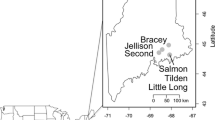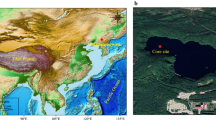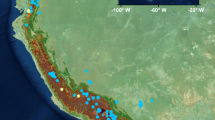Abstract
We examined diatom assemblages in a sediment core from Lake Superior (Canada/USA) that spans the interval ~ 500–1350 CE and includes the Medieval Climate Anomaly (MCA), 950–1250 CE. We sought to determine whether diatom assemblages responded to climate change during that warm, dry period. From 500 to 1350 CE, diatom assemblages were dominated by Lindavia ocellata and Lindavia comensis and there were no significant changes in the diatom community during the MCA. In another core from Lake Superior, which spans the period ~ 1815–2010 CE, we documented significant changes in diatom assemblages, which began ca. 1940. We used recently established relationships between planktonic diatom taxa and climate and lake physicochemical variables from monitoring data, to assess the drivers of change in diatom assemblages during the past century. Results from the two cores suggest that multiple environmental drivers, including both climate change and human-mediated influences on nutrient cycling, led to shifts in recent diatom communities in Lake Superior. The lack of change in diatom assemblages during the MCA supports the conclusion that environmental changes in Lake Superior during the past century are novel and were driven largely by human activities.






Similar content being viewed by others
References
Austin JA, Colman SM (2008) A century of temperature variability in Lake Superior. Limnol Oceanogr 53:2724–2730
Austin JA, Colman SM (2007) Lake Superior summer water temperatures are increasing more rapidly than regional air temperatures: A positive ice-albedo feedback. Geophys Res Lett 34:1–5
Bennett KD (1996) Determination of the number of zones in a biostratigraphical sequence. New Phytol 132:155–170
Booth RK, Jackson ST (2003) A high-resolution record of late-Holocene moisture variability from a Michigan raised bog, USA. Holocene 13:863–876
Booth RK, Notaro M, Jackson ST, Kutzbach JE (2006) Widespread drought episodes in the western Great Lakes region during the past 2000 years: geographic extent and potential mechanisms. Earth Planet Sci Lett 242:415–427
Bramburger AJ, Reavie ED (2016) A comparison of phytoplankton communities of the deep chlorophyll layers and epilimnia of the Laurentian Great Lakes. J Gt Lakes Res 42:1016–1025
Chraïbi VLS, Kireta AR, Reavie ED, Cai M, Brown TN (2014) A paleolimnological assessment of human impacts on Lake Superior. J Gt Lakes Res 40:886–897
De Menocal P, Ortiz J, Guilderson T, Sarnthein M (2000) Coherent high-and low-latitude climate variability during the Holocene warm period. Science 288:2198–2202
Desai AR, Austin JA, Bennington V, McKinley GA (2009) Stronger winds over a large lake in response to weakening air-to-lake temperature gradient. Nat Geosci 2:855–858
Dove A, Chapra SC (2015) Long-term trends of nutrients and trophic response variables for the Great Lakes. Limnol Oceanogr 60:696–721
[GLNPO] Great Lakes National Program Office (2010) Sampling and analytical procedures for GLNPO’s open lake water quality survey of the Great Lakes. U.S. Environ. Protect. Agency, document EPA 905-R-05–001. U.S. EPA, Washington DC
Hobbs WO, Telford RJ, Birks HJB, Saros JE, Hazewinkel RR, Perren BB, Saulnier-Talbot É, Wolfe AP (2010) Quantifying recent ecological changes in remote lakes of North America and Greenland using sediment diatom assemblages. PLoS ONE 5:e10026
Juggins S (2017) rioja: Analysis of Quaternary Science Data, R package version (0.9–15). (https://cran.r-project.org/package=rioja)
Kireta AR (2018) Deciphering Climate-driven Changes in Planktonic Diatom Communities in Lake Superior. (Doctoral dissertation). https://digitalcommons.library.umaine.edu/etd/2833
Kireta AR, Saros JE (2019) Contemporary abundance patterns of Cyclotella sensu lato diatom taxa in Lake Superior: Assessing responses to physical and chemical gradients and potential links to climate change. J Gt Lakes Res 45:119–128
Last WM, Slezak LA (1986) Paleohydrology, sedimentology, and geochemistry of two meromictic saline lakes in southern Saskatchewan. Géograph Phys et Quaternaire 40:5–15
Last WM, Slezak LA (1988) The salt lakes of western Canada: a paleolimnological overview. In: Melack JM (ed) Saline Lakes. Springer, Dordrecht, pp 301–316
Malik HI, Saros JE (2016) Effects of temperature, light and nutrients on five Cyclotella sensu lato taxa assessed with in situ experiments in arctic lakes. J Plankton Res 38:431–442
Malik HI, Northington RM, Saros JE (2017) Nutrient limitation status of Arctic lakes affects the responses of Cyclotella sensu lato diatom species to light: implications for distribution patterns. Pol Biol 40:2445–2456
Mann ME, Zhang Z, Rutherford S, Bradley RS, Hughes MK, Shindell D, Ammann C, Faluvegi G, Fenbiao N (2009) Global signatures and dynamical origins of the Little Ice Age and Medieval Climate Anomaly. Science 326:1256–1260
Newnham RM, Vandergoes MJ, Garnett MH, Lowe DJ, Prior C, Almond PC (2007) Test of AMS 14C dating of pollen concentrates using tephrochronology. J Quat Sci 22:37–51
O’Beirne MD, Werne JP, Hecky RE, Johnson TC, Katsev S, Reavie ED (2017) Anthropogenic climate change has altered primary productivity in Lake Superior. Nat Commun 8(1):1–8
O’Beirne MD (2013) Anthropogenic climate change has driven Lake Superior productivity beyond the range of Holocene variability: An organic and stable isotopic study of human impacts on a pristine biogeochemical system. Master’s thesis, University of Minnesota Duluth, Duluth, MN. https://conservancy.umn.edu/handle/11299//160251
Oksanen J, Blanchet FG, Friendly M, Kindt R, Legendre P, McGlinn D, Minchin PR, O'Hara RB, Simpson GL, Solymos P, Henry M, Stevens H, Szoecs E, Wagner H (2017) vegan: Community Ecology Package. R package version 2.4-4. https://CRAN.R-project.org/package=vegan
Parnell A (2016) Bchron: Radiocarbon dating, age-depth modelling, relative sea level rate estimation, and non-parametric phase modelling. R package version 4.1. 1; 2015
R Core Team (2015) R: A language and environmental for statistical computing. R Foundation for Statistical Computing, Vienna, Austria. URL https://www.R-project.org/
Reavie ED, Sgro GV, Estepp LR, Bramburger AJ, Chraïbi VLS, Pillsbury RW, Cai M, Stow CA, Dove A (2016) Climate warming and changes in Cyclotella sensu lato in the Laurentian Great Lakes. Limnol Oceanogr 62:768–783
Reavie ED, Kireta AR (2015) Centric, araphid and eunotioid diatoms of the coastal Laurentian Great Lakes. Bibl Diatomol 62, Cramer, Berlin
Reavie ED, Barbiero RP, Allinger LE, Warren GJ (2014) Phytoplankton trends in the Great Lakes, 2001–2011. J Gt Lakes Res 40:618–639
Rühland KM, Paterson AM, Smol JP (2015) Lake diatom responses to warming: reviewing the evidence. J Paleolimnol 54:1–35
Saros JE, Anderson NJ (2015) The ecology of the planktonic diatom Cyclotella and its implications for global environmental change studies. Biol Rev 90:522–541
Saros JE, Stone JR, Pederson GT, Slemmons KE, Spanbauer T, Schliep A, Cahl D, Williamson CE, Engstrom DR (2012) Climate-induced changes in lake ecosystem structure inferred from coupled neo-and paleoecological approaches. Ecology 93:2155–2164
Schelske CL, Stoermer EF, Kenney WF (2006) Historic low-level phosphorus enrichment in the Great Lakes inferred from biogenic silica accumulation in sediments. Limnol Oceangr 51:728–748
Simpson GL, Oksanen J (2016) analogue: Analogue matching and Modern Analogue Technique transfer function models. (R package version 0.17–0). (https://cran.r-project.org/package=analogue)
Smol JP, Wolfe AP, Birks HJB, Douglas MS, Jones VJ, Korhola A, Pienitz R, Rühland KM, Sorvari S, Antoniades D, Brooks SJ, Fallu M-A, Hughes M, Keatley BE, Laing TE, Michelutti N, Nazarova L, Nyman M, Paterson AM, Perren B, Quinlan R, Rautio M, Saulnier-Talbot É, Siitonen S, Solovieva N, Weckström J (2005) Climate-driven regime shifts in the biological communities of arctic lakes. Proc Natl Acad Sci USA 102:4397–4402
Spaulding SA, Lubinski DJ, Potapova M (2010) Diatoms of the United States. https://westerndiatoms.colorado.edu Accessed on 07 August 2017
Sterner RW, Anagnostou E, Brovold S, Bullerjahn GS, Finlay JC, Kumar S, McKay RML, Sherrell RM (2007) Increasing stoichiometric imbalance in North America's largest lake: nitrification in Lake Superior. Geophys Res Lett 34:L10406. https://doi.org/10.1029/2006GL028861
Stoermer EF, Kociolek JP, Schelske CL, Conley DJ (1985) Siliceous microfossil succession in the recent history of Lake Superior. Proc Natl Acad Sci Phila 137:106–118
Stuiver M, Polach HA (1977) Discussion reporting of 14 C data. Radiocarbon 19:355–363
Valero-Garcés BL, Laird KR, Fritz SC, Kelts K, Ito E, Grimm EC (1997) Holocene climate in the Northern Great Plains inferred from sediment stratigraphy, stable isotopes, carbonate geochemistry, diatoms, and pollen at Moon Lake, North Dakota. Quater Res 48:359–369
Vance RE, Mathewes RW, Clague JJ (1992) 7000 year record of lake-level change on the northern great plains: A high-resolution proxy of past climate. Geology 20:879–882
Vandergoes MJ, Prior CA (2003) AMS dating of pollen concentrates—a methodological study of late quaternary sediments from south Westland, New Zealand. Radiocarbon 45:479–491
Ward JH Jr (1963) Hierarchical grouping to optimize an objective function. J Amer Stats Assoc 58:236–244
Weiler RR (1978) Chemistry of Lake Superior. J Gt Lakes Res 4:370–385
Winder M, Reuter JE, Schladow SG (2009) Lake warming favours small-sized planktonic diatom species. Proc R Soc B 276:427–435
Wolin JA (1996) Late Holocene lake-level and lake development signals in Lower Herring Lake, Michigan. J Paleolimnol 15:19–45
Xia J, Haskell BJ, Engstrom DR, Ito E (1997) Holocene climate reconstructions from tandem trace-element and stable-isotope composition of ostracods from Coldwater Lake, North Dakota, USA. J Paleolimnol 17:85–100
Acknowledgements
We thank Euan Reavie and Mark Edlund for review of previous drafts. Samples were provided by LacCore, University of Minnesota. Pollen extractions were carried out by Andrea Nurse. This research was funded by the National Science Foundation [DGE 1144423], the Geological Society of America, and a Chase Distinguished Research Fellowship from the University of Maine.
Author information
Authors and Affiliations
Corresponding author
Additional information
Publisher's Note
Springer Nature remains neutral with regard to jurisdictional claims in published maps and institutional affiliations.
Electronic supplementary material
Below is the link to the electronic supplementary material.
Rights and permissions
About this article
Cite this article
Kireta, A.R., Chraïbi, V.L.S., O’Beirne, M.D. et al. Lake superior sedimentary diatom profiles from the Medieval Climate Anomaly and twentieth century suggest recent assemblage changes reflect novel environmental conditions. J Paleolimnol 64, 405–417 (2020). https://doi.org/10.1007/s10933-020-00145-x
Received:
Accepted:
Published:
Issue Date:
DOI: https://doi.org/10.1007/s10933-020-00145-x




